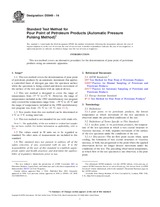Potrebujeme váš súhlas na využitie jednotlivých dát, aby sa vám okrem iného mohli ukazovať informácie týkajúce sa vašich záujmov. Súhlas udelíte kliknutím na tlačidlo „OK“.
ASTM D5949-14
Standard Test Method for Pour Point of Petroleum Products (Automatic Pressure Pulsing Method)
Automaticky preložený názov:
Štandardná skúšobná metóda pre Bod tuhnutia ropných produktov (automatické tlakové Impulzné metóda)
NORMA vydaná dňa 1.5.2014
Informácie o norme:
Označenie normy: ASTM D5949-14
Poznámka: NEPLATNÁ
Dátum vydania normy: 1.5.2014
Kód tovaru: NS-33160
Počet strán: 6
Približná hmotnosť: 18 g (0.04 libier)
Krajina: Americká technická norma
Kategória: Technické normy ASTM
Kategórie - podobné normy:
Anotácia textu normy ASTM D5949-14 :
Keywords:
Peltier, petroleum products, pour point, pressure pulsing, thermoelectric, ICS Number Code 75.080 (Petroleum products in general)
Doplňujúce informácie
| Significance and Use | ||||||||||
|
5.1 The pour point of a petroleum product is an index of the lowest temperature of its utility for certain applications. Flow characteristics, like pour point, can be critical for the correct operation of lubricating oil systems, fuel systems, and pipeline operations. 5.2 Petroleum blending operations require precise measurement of the pour point. 5.3 In most cases, this test method does not require the use of mechanical refrigeration apparatus (see 5.4 This test method yields a pour point in a format similar to Test Method D97/IP 15 when the 3 °C interval results are reported. 5.5 Test results from this test
method can be determined at either 1 °C or 3 °C intervals.
5.6 This test method has better repeatability and reproducibility relative to Test Method D97/IP 15 as measured in the 1992 and 1998 interlaboratory test programs.1.1 This test method covers the determination of pour point of petroleum products by an automatic instrument that applies a controlled burst of nitrogen gas onto the specimen surface while the specimen is being cooled and detects movement of the surface of the test specimen with an optical device. 1.2 This test method is designed to cover the range of temperatures from −57 °C to +51 °C. However, the range of temperatures included in the 1992 interlaboratory test program only covered the temperature range from −39 °C to +6 °C and the range of temperatures included in the 1998 interlaboratory test program was from −51 °C to −11 °C. (see 13.4). 1.3 Test results from this test method can be determined at 1 °C or 3 °C testing intervals. 1.4 This test method is not intended for use with crude oils. 1.5 The values stated in SI units
are to be regarded as standard. No other units of measurement are
included in this standard.
1.6 This standard does not purport to address all of the safety concerns, if any, associated with its use. It is the responsibility of the user of this standard to establish appropriate safety and health practices and determine the applicability of regulatory limitations prior to use. |
||||||||||
| 2. Referenced Documents | ||||||||||
|
Odporúčame:
Aktualizácia technických noriem
Chcete mať istotu, že používate len platné technické normy?
Ponúkame Vám riešenie, ktoré Vám zaistí mesačný prehľad o aktuálnosti noriem, ktoré používate.
Chcete vedieť viac informácií ? Pozrite sa na túto stránku.




 Cookies
Cookies
